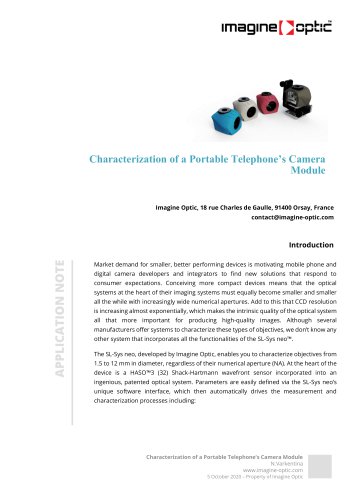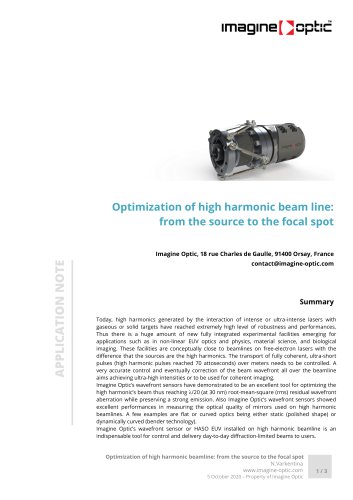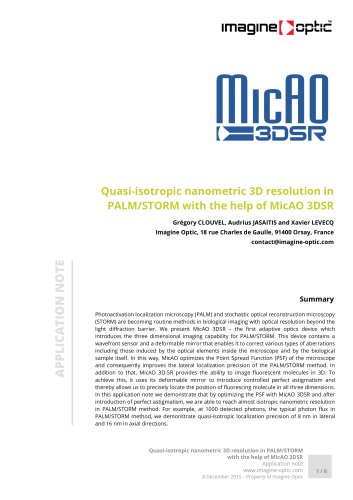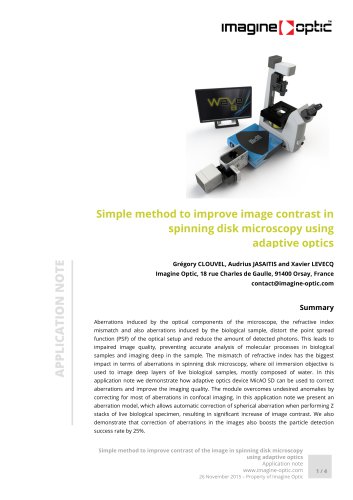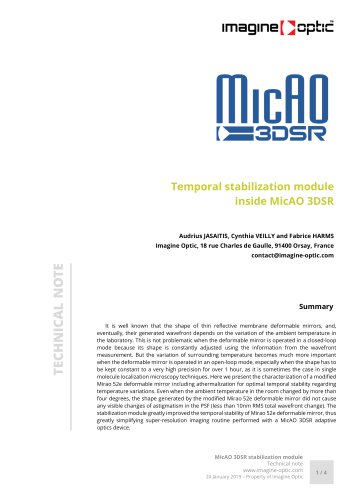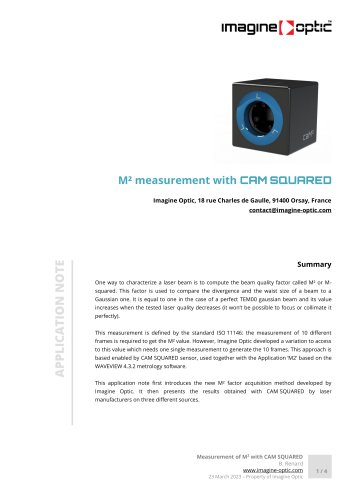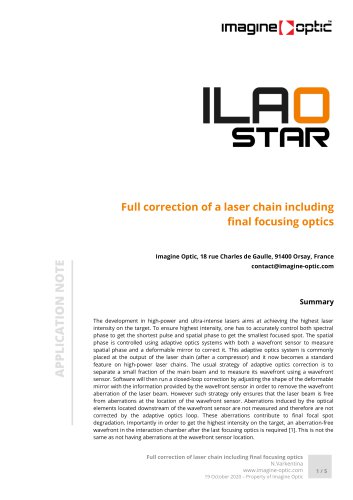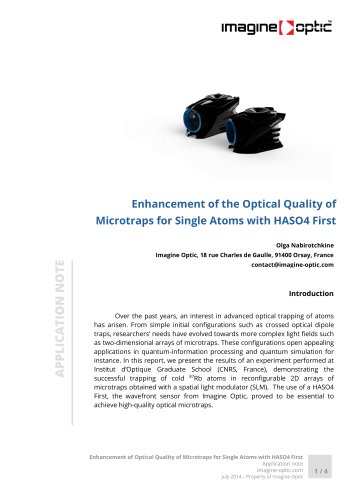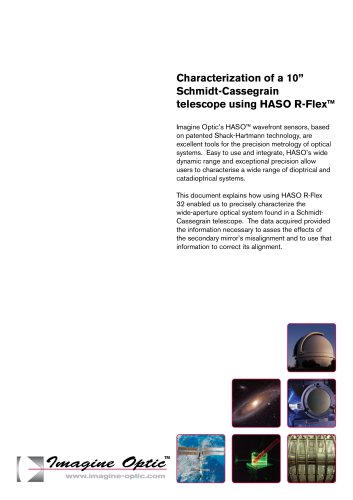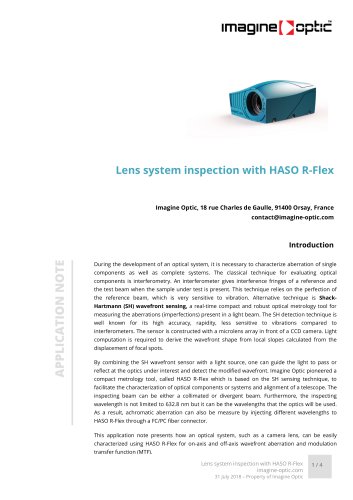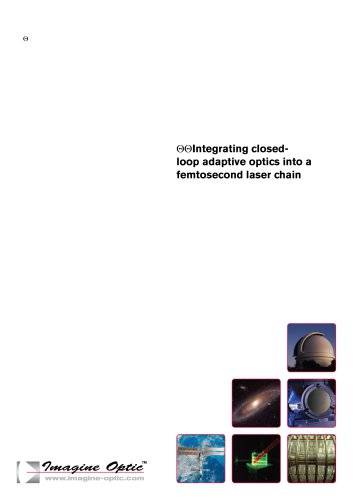
Characterization of a Portable Telephone’s Camera Module - VIS NIR optical metrology Application Notes
1 /
5Pages
Catalog excerpts
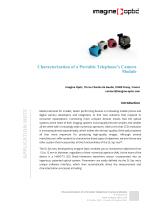
Characterization of a Portable Telephone’s Camera Module Imagine Optic, 18 rue Charles de Gaulle, 91400 Orsay, France contact@imagine-optic.com Introduction Market demand for smaller, better performing devices is motivating mobile phone and digital camera developers and integrators to find new solutions that respond to consumer expectations. Conceiving more compact devices means that the optical systems at the heart of their imaging systems must equally become smaller and smaller all the while with increasingly wide numerical apertures. Add to this that CCD resolution is increasing almost exponentially, which makes the intrinsic quality of the optical system all that more important for producing high-quality images. Although several manufacturers offer systems to characterize these types of objectives, we don’t know any other system that incorporates all the functionalities of the SL-Sys neo™. The SL-Sys neo, developed by Imagine Optic, enables you to characterize objectives from 1.5 to 12 mm in diameter, regardless of their numerical aperture (NA). At the heart of the device is a HASO™3 (32) Shack-Hartmann wavefront sensor incorporated into an ingenious, patented optical system. Parameters are easily defined via the SL-Sys neo’s unique software interface, which then automatically drives the measurement and characterization processes including: Characterization of a Portable Telephone’s Camera Module N.Varkentina www.imagine-optic.com 5 October 2020 – Property of Im
Open the catalog to page 1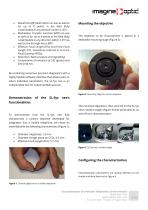
Wavefront (WF) aberrations on-axis as well as for up to 8 points in the field (fully customizable in any direction within ± 45°); Modulation Transfer Function (MTF) on-axis as well as for up to 8 points in the field (fully customizable in any direction within ± 45°) as well as the through-focus MTF; Effective Focal Length (EFL) and Front Focal Length (FFL, sometimes referred to as Front Focal Distance (FFD)); Distortion, field curvature and vignetting; Comparative chromatism at 532 (green) and 635 (red) nm. The objective to be characterized is placed in a dedicated mounting stage (Figure...
Open the catalog to page 2
EFL measured by the two sources provides information on the objective’s chromatism. The results presented here correspond to a Linear Mode characterization of the objective described earlier. The first diagnostic results shown, in the screen capture in Figure 5 in the tab “Wavefront surface,” are a series of 9 wavefront measurements that includes the residual wavefront Root Mean Square (RMS) and Figure 4. SL-Sys neo’s interface Peak-to-Valley (PV) as well as information on vignetting, or diminution of the pupil diameter in the In this dialogue box, the user is presented with 3 operating...
Open the catalog to page 3
The second diagnostic results shown in Figure 6 under Distortion – This indicates the EFL’s evolution (increase or decrease) as a function of the measurements for the 9 measured points in the field, field angle. The direct effect of the distortion is a deformation (barrel or pincushion) of the shown in the upper zone of the window. It is worth image at the outer extremities. noting that, in contrast to typical MTF measurement Field curvature – This measurement relates systems where the MTF is only measured on 2 slits at to the evolution in the field of the focal point 90° (sagittal and...
Open the catalog to page 4
Figure 8. SL-Sys neo’s modul As demonstrated above, the SL-Sys neo was able to completely and precisely characterize an objective designed for a mobile telephone in less than one minute. The extensive data, displayed in a userfriendly and ergonomic interface enables users to make fast use of the information. From calculating the best position for the CCD on the z-axis to determining whether or not the objective’s design meets the prescribed specifications as calculated in optical design software, the SL-Sys neo provides all the information users need to quickly make important decisions on...
Open the catalog to page 5All Imagine Optic catalogs and technical brochures
-
WAVE Suite
3 Pages
Archived catalogs
-
Microtraps
4 Pages
-
AO inside laser chain
5 Pages
-
AO in femtosecond laser
5 Pages
-
Large deformable mirror ILAO
6 Pages
-
NIR optics characterization
6 Pages
-
Telescope characterization
3 Pages
-
absolute measurement
4 Pages
-
HASO R.FLEX
4 Pages
-
HASO3
2 Pages
-
bendAO?
3 Pages
-
HASO?3 WSR Wavefront Sensors
2 Pages
-
HASO R-Flex
3 Pages
-
SL-Sys LIQUID
2 Pages
-
SL-Sys neo
2 Pages
-
HASO™3 Wavefront Sensors
3 Pages

